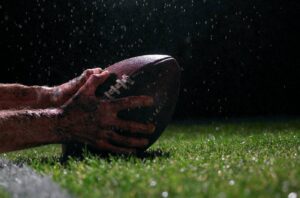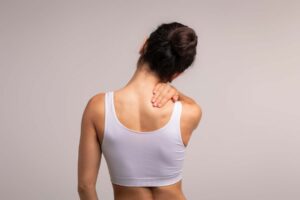
The Shoulder Center
Led by Dr. Charles Ruotolo, Dr. Brett Spain, Dr. Richard McCormack and Dr. Rhyne Dengenis,.
Let us help you find a doctor. Call 855.321.6784 or browse our specialists.
Shoulder Conditions
At Total Orthopedics & Sports Medicine, we treat a variety of conditions involving problems with the Shoulder. Select a condition below to learn more.
Osteoarthritis & Rheumatoid Arthritis
Patients with arthritis of the shoulder will suffer from a stiff and painful shoulder, with that shoulder having a limited range of movement. Pain that intensifies with use is common as is painful interruption of sleep. It is also common to hear a catching or clicking noise.
Osteoarthritis is a progressive degeneration of the joints. It occurs when cartilage that allows the joint to move smoothly is damaged. Over time this cartilage is worn away and adjacent bones are remodeled as the joint becomes increasingly abnormal and “rusty”, resulting in pain and stiffness. This diagnosis simply comes from wear and tear.
Rheumatoid Arthritis is an autoimmune condition that is also very common. A patient suffering from RA might also experience:
- Tenderness and warmth in the shoulder joints
- Stiffness in one or both shoulders, especially in the morning
- Rheumatoid nodules, which are bumps under the skin in shoulders or arms
- Tiredness, weight loss, or a fever
RA affects the joint lining and can cause joint swelling as well. Over time, it can cause erosion of the shoulder bones and deformity of the shoulder joints.
Rotator Cuff Tears
The rotator cuff is the cuff of tendons that surround the top of the humerus. These tendons attach the four muscles of the rotator cuff that originate on the shoulder blade and help to rotate and elevate the arm.
Over time, the tendons of the rotator cuff can become damaged due to small micro tears or trauma. Rotator cuff tears may also occur from a traumatic injury such as a fall on the shoulder or arm. The weakening and degeneration of this tendon can lead to pain and weakness in the shoulder. In more severe cases, the tendon may tear completely causing the bones of the shoulder to rub together. Some Rotator Cuff Tears are brought on by the formation of bone spurs that rub against the joint and irritate the tendons.
Athletes whose respective sport requires repetitive throwing motions are susceptible to this injury as well as those whose occupation may require repetitive motion, especially overhead motion of the shoulder.
Signs and symptoms of a Rotator Cuff Tear may include:
- Pain when raising the arms
- Pain in the shoulder especially pain at night
- “Catching” “locking” or “popping” of the shoulder joint
- Decreased range of motion
- Weakness in the affected arm
SLAP Tears
A SLAP tear is a term to describe an injury to the top of the shoulder labrum. SLAP stands for “superior labrum anterior posterior”. The labrum is a type of cartilage found in the ball and socket joint of the shoulder where it meets the arm bone. The labrum is the cartilage that surrounds the socket making the socket deeper and adding stability to the ball (the head of the humerus) sitting on the socket (the glenoid). These two bones are connected by strong ligaments which hold the bones in place, very similar to the ball and socket joint of the hip. However, the shoulder joint is not as deep as the hip joint and is predisposed to being unstable.
Over time, the superior labrum can become damaged due to small micro tears or trauma such as with overhand sports or with a sudden pull on the shoulder as with a traction injury to the arm in the overhead position. The tearing of this cartilage can lead to pain, clicking and popping, and instability of the shoulder
Athletes whose positions require repetitive throwing motions are susceptible to this injury as well as those whose jobs require repetitive overhead motion of the shoulder. Depending upon the severity and type of injury, the labrum may be partially or completely torn. If there is suspicion of a labral tear, it is important to seek medical attention as this condition may worsen if left untreated.
Signs and symptoms of a Superior Labral Tear may include:
- Pain when raising the arms
- Pain in the shoulder
- “Catching”, “locking” or “popping” of the shoulder joint
- Pain with throwing especially in the” late cocking, early acceleration” phase of throwing
- The feeling of instability or looseness of the shoulder
Shoulder Separation
A shoulder separation, also called an AC joint separation is an injury to the acromioclavicular (AC) joint located at the top of the shoulder. A shoulder separation occurs at the spot where the clavicle and the acromion process of the scapula meet. This injury is often confused with a shoulder dislocation, however these are two different cases.
A Separated Shoulder is most often the result of a traumatic incident such as a sports injury or slip and fall where there is a direct force to the shoulder joint pushing the shoulder down. Typically there is pain at the top of the shoulder and prominence of the clavicle (the collarbone) with the arm lower than the other extremity.
Signs and symptoms of an AC Joint separation may include:
- Pain in the shoulder
- Visible deformity at the area of injury with prominence of the collarbone
- Swelling or bruising
- Loss of full range of motion
- Weakness in the affected shoulder and arm
Shoulder Fracture
Fractures to one or more bones that comprise the shoulder are known as a Shoulder Fracture. Most Shoulder Fractures occur as a result of a direct trauma such as a sports injury, motor vehicle accident or a slip and fall.
Shoulder Fractures are classified into two separate types:
Displaced: In this form of fracture the pieces of the fractured bone are separated from themselves. We describe these by how many parts are displaced. (usually 2, 3, or 4 parts are encountered) Treatment is dictated by how many parts are displaced and the age and health of the patient. Typically 2, 3, and 4 part fractures are treated surgically where the fracture pieces are put back together. In older patients some 3 and 4 part fractures require a partial shoulder replacement or a special replacement called a reverse shoulder arthroplasty.
Non-displaced: In this form of fracture pieces of the fractured bone are aligned with each other and not displaced. 80% of shoulder fractures end up as non-displaced fractures. In this type of injury stiffness is the most common complication. An early period of immobilization is required in a sling but motion exercises are usually quickly instituted by the physician.
Signs and symptoms of Shoulder Fractures may include:
- Shoulder Pain
- Swelling and /or tenderness in the shoulder
- Visible deformity or bump at the site of fracture
- Discoloration or bruising of the upper arm
- Inability to move or lift the arm without pain
Shoulder Fracture
Fractures to one or more bones that comprise the shoulder are known as a Shoulder Fracture. Most Shoulder Fractures occur as a result of a direct trauma such as a sports injury, motor vehicle accident or a slip and fall.
Shoulder Fractures are classified into two separate types:
Displaced: In this form of fracture the pieces of the fractured bone are separated from themselves. We describe these by how many parts are displaced. (usually 2, 3, or 4 parts are encountered) Treatment is dictated by how many parts are displaced and the age and health of the patient. Typically 2, 3, and 4 part fractures are treated surgically where the fracture pieces are put back together. In older patients some 3 and 4 part fractures require a partial shoulder replacement or a special replacement called a reverse shoulder arthroplasty.
Non-displaced: In this form of fracture pieces of the fractured bone are aligned with each other and not displaced. 80% of shoulder fractures end up as non-displaced fractures. In this type of injury stiffness is the most common complication. An early period of immobilization is required in a sling but motion exercises are usually quickly instituted by the physician.
Signs and symptoms of Shoulder Fractures may include:
- Shoulder Pain
- Swelling and /or tenderness in the shoulder
- Visible deformity or bump at the site of fracture
- Discoloration or bruising of the upper arm
- Inability to move or lift the arm without pain
Shoulder Procedures
At Total Orthopedics & Sports Medicine, we treat a variety of conditions involving problems with the Shoulder. Select a procedure below to learn more.
Total and Partial Shoulder Replacement
Total shoulder replacement, also known as total shoulder arthroplasty, is a successful procedure for treating the severe pain and stiffness that often result at the end stage of various forms of arthritis or degenerative joint disease in the shoulder. The primary goal of shoulder replacement surgery is pain relief, with an added benefit of restoring full motion, strength and function as quickly as possible. Many patients return to the sports they love like tennis, golf and swimming, while also being able to pursue the personal health initiatives that they so choose.
Painful shoulder arthritis refers to the disappearing of the cartilage surfaces of the shoulder, which permit the ball and socket to smoothly glide against one another. This disappearance of the cartilage covering results in a bone on bone joint and can be quite painful.
The damaged portions of cartilage between the humerus and glenoid are completely removed as well as a small piece of bone. The space created by the removal of cartilage and bone is then replaced by a metal implant that replaces the ball of the humerus that is designed the keep the shoulder mobile and flexible.
Next, a small plastic socket is cemented in place on the glenoid.(the socket of the shoulder). These components create a smooth surface for the shoulder joints to glide on. If only the ball of the humerus is replaced it would be labeled a partial shoulder replacement or hemiarthroplasty. This is sometimes done in young patients with osteoarthritis or in fracture situations.
Shoulder Dislocation/Instability & Labral Repair
In a fully functional shoulder, the ball portion of the shoulder joint moves approximately one inch in a forward or backward direction within the socket. A patient who seeks medical care for shoulder instability usually has either a partial dislocation or subluxation, in which the ball becomes partially dislocated from the socket, or a complete dislocation of the shoulder, in which the ball moves fully out of the socket. Micro-instability may occur in overhead athletes whose throwing activity results in labral tear where the shoulder just mildly subluxates.
Partial and complete dislocations may occur either as the result of a single traumatic event, as when a football player makes a tackle, or in a person with inherent looseness in the joint, as a result of repetitive activities such as swimming. The latter group is described as having loose-jointed shoulders and are at risk for non-traumatic shoulder instability, allowing the joint to have greater degrees of movement or looseness. In some patients instability of the shoulder can be from an underlying disorder of collagen (the fibers that form the ligaments of the shoulder).
Shoulder Debridement
Shoulder Debridement is a procedure used to remove debris and damaged tissue in the shoulder joint. Tissue damage in the shoulder joint can have a number of different causes. While it could occur due to injury or trauma, it is very common for tissue to be damaged by a degenerative condition like osteoarthritis or fraying of the rotator cuff tendons or cartilage of the labrum. The tissue in the joint deteriorates with normal wear and tear as the body gets older, so injuries that can cause debris in the joint, like rotator cuff tears or osteoarthritis, can occur naturally as the body ages.
This procedure is done as minimally invasive as possible, using several tiny incisions. A small camera called an arthroscope is inserted into one of the incisions. The joint is inflated with fluid. This expands the joint, giving the surgeon more space to examine the damage. The surgeon uses special tools to repair the damage found. During this process, loose or damaged cartilage is removed. If present, bone spurs may be filed down to avoid further complication.
This procedure is almost always performed as an outpatient procedure, so patients who undergo it are able to leave the facility that day.
Acromioplasty or Subacromial Decompression and Shoulder Impingement
Shoulder Impingement occurs when the top of the humerus and the rotator cuff tendons that insert on the top of the humerus rub on the acromion, the bone above the humerus. This can occur due to weakness of the rotator cuff muscles as with rotator cuff tendonitis, partial tears, and full thickness tears as well as with neurologic disorders that weaken the muscles such as a pinched nerve from the neck. Shoulder impingement causes pain when elevating the arm usually in the range between 70 and 120 degrees of elevation. This typically can be treated by physical therapy strengthening the rotator cuff muscles and the shoulder blade muscles.
For those who fail a prolonged course of physical therapy (usually meaning 3 months) an arthroscopic procedure may be performed. Through several tiny incisions a camera is inserted into the space between the tendons and the acromion (the bone above the tendons). Impingement is something that can be visualized as the bone above will appear frayed from the repetitive rubbing from the tendons and humerus as the arm is raised. In this situation a small mechanical tool is used to remove the excess bone and bone spurs of the acromion so the impingement is relieved. This is a relatively quick procedure that is performed in an outpatient setting where the patient goes home the day of the surgery.
Distal Clavicle Excision
Distal Clavicle Excision is a procedure used to treat arthritis of the end of the collarbone. With arthritis of the AC joint there is pain and clicking in the top of the shoulder. Pain is worse with pressing and pushing as well as with sleeping on the affected side. This procedure removes the end of the clavicle closest to the AC joint in order to subside the pain and restore normal mobility.
This procedure is done as minimally invasive as possible, using several small incisions. A small camera called an arthroscope is inserted into one of the incisions. The surgeon will use a cutting tool to remove a small portion of the clavicle that is causing the pain.
Symptoms of AC joint arthritis may include:
- Minor pain even while the shoulder is resting
- Pain in the top or superior aspect of the shoulder
- Pain reaching across the body or reaching behind the back
- Pain with presses or push ups
- Pain at night especially sleeping on the affected side
Calcific Tendonitis & Debridement
Calcific tendonitis of the shoulder occurs when calcium deposits form in the tendons of the shoulder. The tissues around the deposit will become inflamed, causing a great deal of shoulder pain. This condition is fairly common, especially with women in middle age.
A surgical debridement is required if the pain is not controlled non-surgically, or the pain at night becomes too much to bear. The goal of the procedure is to remove the calcium in the tendon relieving the pressure caused by the deposit.
Adhesive Capsulitis and Capsular Release
Adhesive capsulitis, also known as frozen shoulder, is an extremely painful condition in which the patient loses motion of the shoulder joint. It is one of the most painful conditions of the shoulder.
Frozen shoulder often starts out of the blue, but may be triggered by a mild injury to the shoulder. The condition usually goes through 4 phases, starting with pain, then stiffness and pain, followed by just resolving stiffness and finally a stage where you might be left with some motion loss. This disease is caused by inflammation of the joint capsule. This is what first presents as pain. Quickly this evolves into the second stage of pain and stiffness. During this phase, left untreated, the shoulder gets progressively stiffer. Eventually, usually 4-6 months, the inflammation of the capsule resolves. This usually occurs with a change in the quality of the shoulder pain. In this phase 3, the constant pain of inflammation resolves and pain only occurs with motion, especially trying to move the shoulder to the extremes of motion. It is in phase three that patients start to see a resolution of their stiffness.
Treatment of adhesive capsulitis includes a corticosteroid injection into the shoulder joint early in the course of the disease. Best results are in phase 1 or early in phase 2. This can stop the inflammation of the capsule and push a patient into phase 3. Besides injections stretching (at home and with physical therapy) is the mainstay of treatment for adhesive capsulitis. The patient should do a home program where they stretch multiple times per day to restore their motion. For those patients who have no progression of their motion over 3 straight months while in phase 3 surgery to do a capsular release may be indicated. Surgery, while the patient is still inflamed in phase 2, has a high recurrence rate of stiffness.
A capsular release involves making 2 or 3 small holes in the shoulder and releasing the tight capsule surgically. A manipulation involves forcibly moving the capsule under anesthetic. A nerve block can be used as an anesthetics that can render the arm numb for up to 24 hours or more. This treatment does not provide an instant cure, but usually, provide a good return to function and motion and a marked decrease in pain within the first 3 months.







 Website Design by
Website Design by